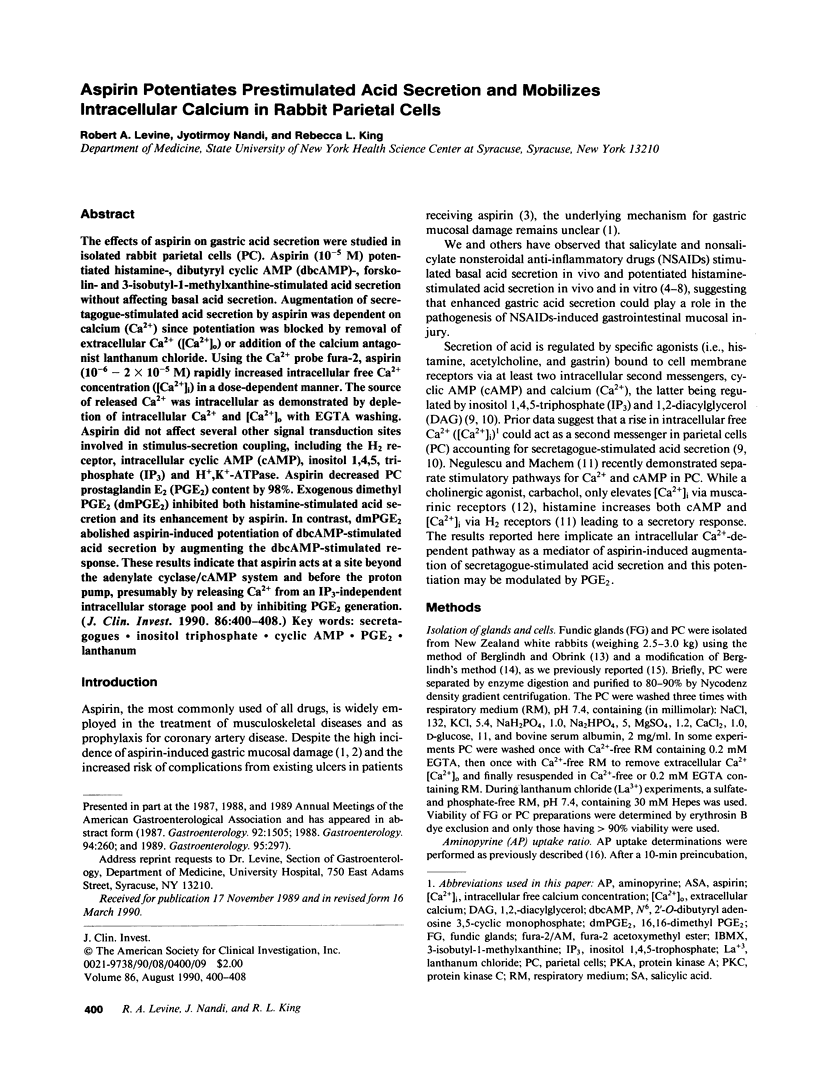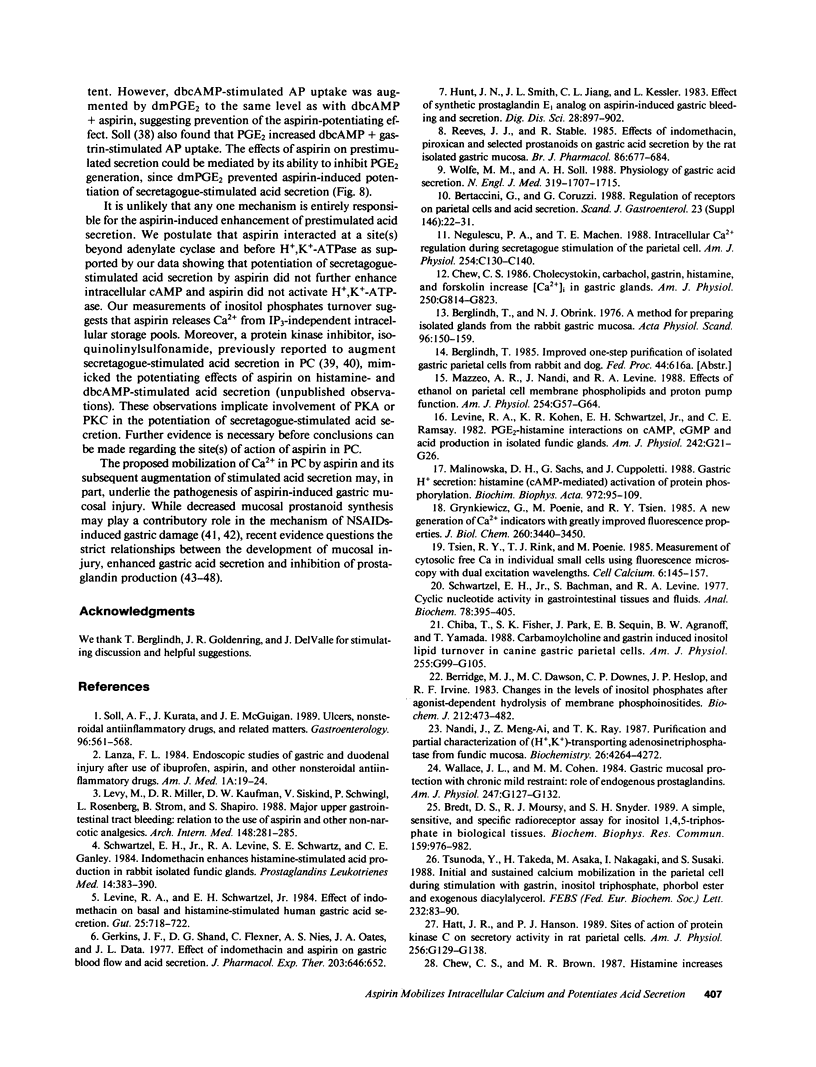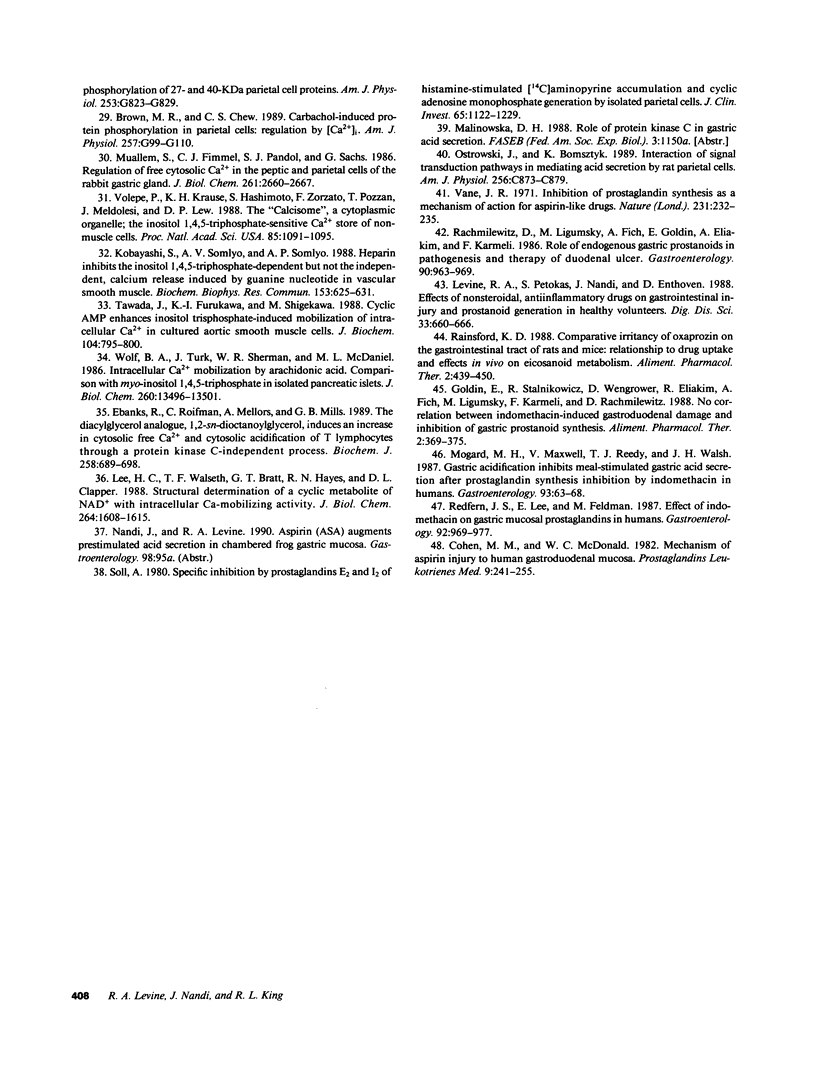Abstract
The effects of aspirin on gastric acid secretion were studied in isolated rabbit parietal cells (PC). Aspirin (10(-5) M) potentiated histamine-, dibutyryl cyclic AMP (dbcAMP)-, forskolin- and 3-isobutyl-1-methylxanthine-stimulated acid secretion without affecting basal acid secretion. Augmentation of secretagogue-stimulated acid secretion by aspirin was dependent on calcium (Ca2+) since potentiation was blocked by removal of extracellular Ca2+ ([Ca2+]o) or addition of the calcium antagonist lanthanum chloride. Using the Ca2+ probe fura-2, aspirin (10(-6) - 2 X 10(-5) M) rapidly increased intracellular free Ca2+ concentration ([Ca2+]i) in a dose-dependent manner. The source of released Ca2+ was intracellular as demonstrated by depletion of intracellular Ca2+ and [Ca2+]o with EGTA washing. Aspirin did not affect several other signal transduction sites involved in stimulus-secretion coupling, including the H2 receptor, intracellular cyclic AMP (cAMP), inositol 1,4,5, triphosphate (IP3) and H+,K(+)-ATPase. Aspirin decreased PC prostaglandin E2 (PGE2) content by 98%. Exogenous dimethyl PGE2 (dmPGE2) inhibited both histamine-stimulated acid secretion and its enhancement by aspirin. In contrast, dmPGE2 abolished aspirin-induced potentiation of dbcAMP-stimulated acid secretion by augmenting the dbcAMP-stimulated response. These results indicate that aspirin acts at a site beyond the adenylate cyclase/cAMP system and before the proton pump, presumably by releasing Ca2+ from an IP3-independent intracellular storage pool and by inhibiting PGE2 generation.
Full text
PDF








Images in this article
Selected References
These references are in PubMed. This may not be the complete list of references from this article.
- Berglindh T., Obrink K. J. A method for preparing isolated glands from the rabbit gastric mucosa. Acta Physiol Scand. 1976 Feb;96(2):150–159. doi: 10.1111/j.1748-1716.1976.tb10184.x. [DOI] [PubMed] [Google Scholar]
- Berridge M. J., Dawson R. M., Downes C. P., Heslop J. P., Irvine R. F. Changes in the levels of inositol phosphates after agonist-dependent hydrolysis of membrane phosphoinositides. Biochem J. 1983 May 15;212(2):473–482. doi: 10.1042/bj2120473. [DOI] [PMC free article] [PubMed] [Google Scholar]
- Bertaccini G., Coruzzi G. Regulation of receptors on parietal cells on acid secretion. Scand J Gastroenterol Suppl. 1988;146:22–33. doi: 10.3109/00365528809099127. [DOI] [PubMed] [Google Scholar]
- Bredt D. S., Mourey R. J., Snyder S. H. A simple, sensitive, and specific radioreceptor assay for inositol 1,4,5-trisphosphate in biological tissues. Biochem Biophys Res Commun. 1989 Mar 31;159(3):976–982. doi: 10.1016/0006-291x(89)92204-3. [DOI] [PubMed] [Google Scholar]
- Chew C. S. Cholecystokinin, carbachol, gastrin, histamine, and forskolin increase [Ca2+]i in gastric glands. Am J Physiol. 1986 Jun;250(6 Pt 1):G814–G823. doi: 10.1152/ajpgi.1986.250.6.G814. [DOI] [PubMed] [Google Scholar]
- Cohen M. M., MacDonald W. C. Mechanism of aspirin injury to human gastroduodenal mucosa. Prostaglandins Leukot Med. 1982 Aug;9(2):241–255. doi: 10.1016/0262-1746(82)90013-0. [DOI] [PubMed] [Google Scholar]
- Ebanks R., Roifman C., Mellors A., Mills G. B. The diacylglycerol analogue, 1,2-sn-dioctanoylglycerol, induces an increase in cytosolic free Ca2+ and cytosolic acidification of T lymphocytes through a protein kinase C-independent process. Biochem J. 1989 Mar 15;258(3):689–698. doi: 10.1042/bj2580689. [DOI] [PMC free article] [PubMed] [Google Scholar]
- Gerkens J. F., Shand D. G., Flexner C., Nies A. S., Oates J. A., Data J. L. Effect of indomethacin and aspirin on gastric blood flow and acid secretion. J Pharmacol Exp Ther. 1977 Dec;203(3):646–652. [PubMed] [Google Scholar]
- Goldin E., Stalnikowicz R., Wengrower D., Eliakim R., Fich A., Ligumsky M., Karmeli F., Rachmilewitz D. No correlation between indomethacin-induced gastroduodenal damage and inhibition of gastric prostanoid synthesis. Aliment Pharmacol Ther. 1988 Aug;2(4):369–375. doi: 10.1111/j.1365-2036.1988.tb00710.x. [DOI] [PubMed] [Google Scholar]
- Grynkiewicz G., Poenie M., Tsien R. Y. A new generation of Ca2+ indicators with greatly improved fluorescence properties. J Biol Chem. 1985 Mar 25;260(6):3440–3450. [PubMed] [Google Scholar]
- Hatt J. F., Hanson P. J. Sites of action of protein kinase C on secretory activity in rat parietal cells. Am J Physiol. 1989 Jan;256(1 Pt 1):G129–G138. doi: 10.1152/ajpgi.1989.256.1.G129. [DOI] [PubMed] [Google Scholar]
- Hunt J. N., Smith J. L., Jiang C. L., Kessler L. Effect of synthetic prostaglandin E1 analog on aspirin-induced gastric bleeding and secretion. Dig Dis Sci. 1983 Oct;28(10):897–902. doi: 10.1007/BF01317040. [DOI] [PubMed] [Google Scholar]
- Kobayashi S., Somlyo A. V., Somlyo A. P. Heparin inhibits the inositol 1,4,5-trisphosphate-dependent, but not the independent, calcium release induced by guanine nucleotide in vascular smooth muscle. Biochem Biophys Res Commun. 1988 Jun 16;153(2):625–631. doi: 10.1016/s0006-291x(88)81141-0. [DOI] [PubMed] [Google Scholar]
- Lanza F. L. Endoscopic studies of gastric and duodenal injury after the use of ibuprofen, aspirin, and other nonsteroidal anti-inflammatory agents. Am J Med. 1984 Jul 13;77(1A):19–24. doi: 10.1016/s0002-9343(84)80014-5. [DOI] [PubMed] [Google Scholar]
- Lee H. C., Walseth T. F., Bratt G. T., Hayes R. N., Clapper D. L. Structural determination of a cyclic metabolite of NAD+ with intracellular Ca2+-mobilizing activity. J Biol Chem. 1989 Jan 25;264(3):1608–1615. [PubMed] [Google Scholar]
- Levine R. A., Kohen K. R., Schwartzel E. H., Jr, Ramsay C. E. Prostaglandin E2-histamine in interactions on cAMP, cGMP, and acid production in isolated fundic glands. Am J Physiol. 1982 Jan;242(1):G21–G26. doi: 10.1152/ajpgi.1982.242.1.G21. [DOI] [PubMed] [Google Scholar]
- Levine R. A., Petokas S., Nandi J., Enthoven D. Effects of nonsteroidal, antiinflammatory drugs on gastrointestinal injury and prostanoid generation in healthy volunteers. Dig Dis Sci. 1988 Jun;33(6):660–666. doi: 10.1007/BF01540427. [DOI] [PubMed] [Google Scholar]
- Levine R. A., Schwartzel E. H. Effect of indomethacin on basal and histamine stimulated human gastric acid secretion. Gut. 1984 Jul;25(7):718–722. doi: 10.1136/gut.25.7.718. [DOI] [PMC free article] [PubMed] [Google Scholar]
- Levy M., Miller D. R., Kaufman D. W., Siskind V., Schwingl P., Rosenberg L., Strom B., Shapiro S. Major upper gastrointestinal tract bleeding. Relation to the use of aspirin and other nonnarcotic analgesics. Arch Intern Med. 1988 Feb;148(2):281–285. doi: 10.1001/archinte.148.2.281. [DOI] [PubMed] [Google Scholar]
- Malinowska D. H., Sachs G., Cuppoletti J. Gastric H+ secretion: histamine (cAMP-mediated) activation of protein phosphorylation. Biochim Biophys Acta. 1988 Oct 28;972(1):95–109. doi: 10.1016/0167-4889(88)90106-1. [DOI] [PubMed] [Google Scholar]
- Mazzeo A. R., Nandi J., Levine R. A. Effects of ethanol on parietal cell membrane phospholipids and proton pump function. Am J Physiol. 1988 Jan;254(1 Pt 1):G57–G64. doi: 10.1152/ajpgi.1988.254.1.G57. [DOI] [PubMed] [Google Scholar]
- Mogard M. H., Maxwell V., Reedy T. J., Walsh J. H. Gastric acidification inhibits meal-stimulated gastric acid secretion after prostaglandin synthesis inhibition by indomethacin in humans. Gastroenterology. 1987 Jul;93(1):63–68. doi: 10.1016/0016-5085(87)90315-5. [DOI] [PubMed] [Google Scholar]
- Muallem S., Fimmel C. J., Pandol S. J., Sachs G. Regulation of free cytosolic Ca2+ in the peptic and parietal cells of the rabbit gastric gland. J Biol Chem. 1986 Feb 25;261(6):2660–2667. [PubMed] [Google Scholar]
- Nandi J., Zhou M. A., Ray T. K. Purification and partial characterization of the (H+,K+)-transporting adenosinetriphosphatase from fundic mucosa. Biochemistry. 1987 Jul 14;26(14):4264–4272. doi: 10.1021/bi00388a013. [DOI] [PubMed] [Google Scholar]
- Negulescu P. A., Machen T. E. Intracellular Ca regulation during secretagogue stimulation of the parietal cell. Am J Physiol. 1988 Jan;254(1 Pt 1):C130–C140. doi: 10.1152/ajpcell.1988.254.1.C130. [DOI] [PubMed] [Google Scholar]
- Ostrowski J., Bomsztyk K. Interaction of signal transduction pathways in mediating acid secretion by rat parietal cells. Am J Physiol. 1989 Apr;256(4 Pt 1):C873–C879. doi: 10.1152/ajpcell.1989.256.4.C873. [DOI] [PubMed] [Google Scholar]
- Rachmilewitz D., Ligumsky M., Fich A., Goldin E., Eliakim A., Karmeli F. Role of endogenous gastric prostanoids in the pathogenesis and therapy of duodenal ulcer. Gastroenterology. 1986 Apr;90(4):963–969. doi: 10.1016/0016-5085(86)90874-7. [DOI] [PubMed] [Google Scholar]
- Rainsford K. D. Comparative irritancy of oxaprozin on the gastrointestinal tract of rats and mice: relationship to drug uptake and effects in vivo on eicosanoid metabolism. Aliment Pharmacol Ther. 1988 Oct;2(5):439–450. doi: 10.1111/j.1365-2036.1988.tb00717.x. [DOI] [PubMed] [Google Scholar]
- Redfern J. S., Lee E., Feldman M. Effect of indomethacin on gastric mucosal prostaglandins in humans. Correlation with mucosal damage. Gastroenterology. 1987 Apr;92(4):969–977. doi: 10.1016/0016-5085(87)90972-3. [DOI] [PubMed] [Google Scholar]
- Reeves J. J., Stables R. Effects of indomethacin, piroxicam and selected prostanoids on gastric acid secretion by the rat isolated gastric mucosa. Br J Pharmacol. 1985 Nov;86(3):677–684. doi: 10.1111/j.1476-5381.1985.tb08945.x. [DOI] [PMC free article] [PubMed] [Google Scholar]
- Schwartzel E. H., Jr, Bachman S., Levine R. A. Cyclic nucleotide activity in gastrointestinal tissues and fluids. Anal Biochem. 1977 Apr;78(2):395–405. doi: 10.1016/0003-2697(77)90100-2. [DOI] [PubMed] [Google Scholar]
- Schwartzel E. H., Jr, Levine R. A., Schwartz S. E., Ganley C. E. Indomethacin enhances histamine-stimulated acid production in rabbit isolated fundic glands. Prostaglandins Leukot Med. 1984 Jun;14(3):383–390. doi: 10.1016/0262-1746(84)90121-5. [DOI] [PubMed] [Google Scholar]
- Soll A. H., Kurata J., McGuigan J. E. Ulcers, nonsteroidal antiinflammatory drugs, and related matters. Gastroenterology. 1989 Feb;96(2 Pt 2 Suppl):561–568. doi: 10.1016/s0016-5085(89)80051-4. [DOI] [PubMed] [Google Scholar]
- Soll A. H. Specific inhibition by prostaglandins E2 and I2 of histamine-stimulated [14C]aminopyrine accumulation and cyclic adenosine monophosphate generation by isolated canine parietal cells. J Clin Invest. 1980 May;65(5):1222–1229. doi: 10.1172/JCI109777. [DOI] [PMC free article] [PubMed] [Google Scholar]
- Tawada Y., Furukawa K., Shigekawa M. Cyclic AMP enhances inositol trisphosphate-induced mobilization of intracellular Ca2+ in cultured aortic smooth muscle cells. J Biochem. 1988 Nov;104(5):795–800. doi: 10.1093/oxfordjournals.jbchem.a122552. [DOI] [PubMed] [Google Scholar]
- Tsien R. Y., Rink T. J., Poenie M. Measurement of cytosolic free Ca2+ in individual small cells using fluorescence microscopy with dual excitation wavelengths. Cell Calcium. 1985 Apr;6(1-2):145–157. doi: 10.1016/0143-4160(85)90041-7. [DOI] [PubMed] [Google Scholar]
- Tsunoda Y., Takeda H., Asaka M., Nakagaki I., Sasaki S. Initial and sustained calcium mobilizations in the parietal cell during stimulations with gastrin, inositol trisphosphate, phorbol ester and exogenous diacylglycerol. FEBS Lett. 1988 May 9;232(1):83–90. doi: 10.1016/0014-5793(88)80391-0. [DOI] [PubMed] [Google Scholar]
- Vane J. R. Inhibition of prostaglandin synthesis as a mechanism of action for aspirin-like drugs. Nat New Biol. 1971 Jun 23;231(25):232–235. doi: 10.1038/newbio231232a0. [DOI] [PubMed] [Google Scholar]
- Volpe P., Krause K. H., Hashimoto S., Zorzato F., Pozzan T., Meldolesi J., Lew D. P. "Calciosome," a cytoplasmic organelle: the inositol 1,4,5-trisphosphate-sensitive Ca2+ store of nonmuscle cells? Proc Natl Acad Sci U S A. 1988 Feb;85(4):1091–1095. doi: 10.1073/pnas.85.4.1091. [DOI] [PMC free article] [PubMed] [Google Scholar]
- Wolfe M. M., Soll A. H. The physiology of gastric acid secretion. N Engl J Med. 1988 Dec 29;319(26):1707–1715. doi: 10.1056/NEJM198812293192605. [DOI] [PubMed] [Google Scholar]





